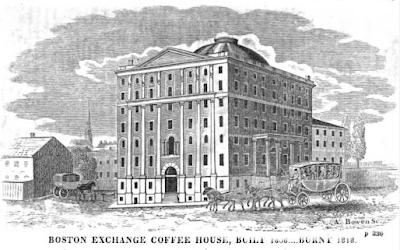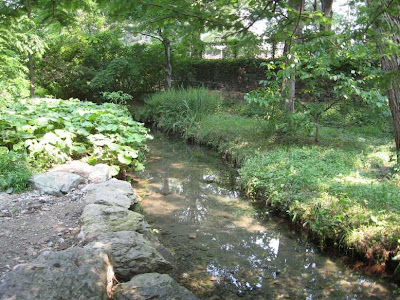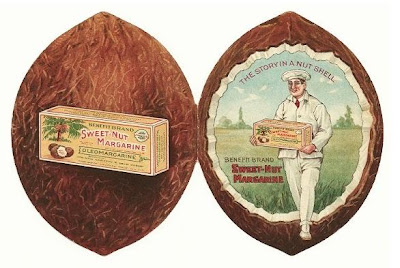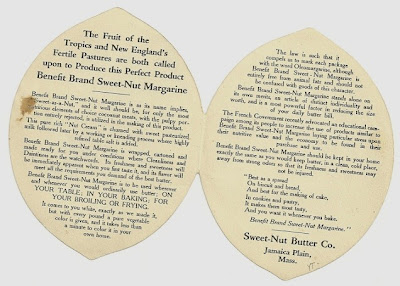
This 1859 map shows the location of the former Hatch house on Centre street, marked in red. The house sat between today's Soldier's Monument on the right and today's
Arborway rotary, near the intersection on the left.
I've been sitting on this entry for far too long, in hopes that I would develop more information on the subject,
Crowell Hatch. While I haven't found the information I've been looking for, I have discovered an interesting source I can direct readers towards - more on that later.
Crowell Hatch was born in
Marshfield in 1740. He followed the route of many at the time, going to sea, becoming a Captain, and then retiring to shore to become a trader, buying ships, provisioning and stocking them, and sending crews out to trade in foreign lands. Hatch first shows up in Jamaica Plain in 1799, buying xx acres of land from Timothy Penny, then of the island of Jamaica. The estate ran between Centre and Pond streets (then the Road to Newton), following approximately the path of today's Orchard street. I've trace the history of this property back in time to Hatch and Penny in a
previous article. This was at the same time when James Perkins, who was following a very similar career path, was buying his estate on the opposite side of Jamaica Pond.
Hatch's estate also stood adjacent to that of John Hancock, though Hancock no longer inhabited that house.
Hatch has entered into a second earlier article, in which I discussed
the Boit family. In 1789, Hatch, then 49 years old, married Hannah
Boit, the 24 year old daughter of John
Boit, and merchant, importer and leading citizen of Boston. Ten years later, he bought an estate in Jamaica Plain from Timothy Penny.

The Columbia, as drawn by the ship's artist, George Davidson.
Crowell Hatch has two claims to fame that come down through the years to us; both as an investor, rather than a ship's captain. The first is the voyage of the Columbia, the first American ship to circumnavigate the globe. Following the publication of Captain Cook's journal in 1784, a group of partners including Hatch (then a resident of Cambridge) bought the Columbia, originally built in the North river yards between
Scituate and
Marshfield. The ship was put under the command of Captain John Kendrick, with a smaller sloop joining the voyage under the command of Captain.Robert Grey. (Here, I'll add that the Columbia carried in its crew one John
Boit, son of John
Boit mentioned above).
The goal of the voyage was to collect sea otter skins from the Pacific Northwest and trade them in China. Western traders suffered a fatal weakness when dealing with China at the time. While China had many products desired by the West - primarily tea - the West had little to offer China other than silver. As the United States had no source of silver at the time, expensive three-way trading was required to satisfy the Chinese and gain access to Chinese markets. Sea otter fur was of very high quality, and the Russians had been recently using it in their own China trade.

The full story of the Columbia is beyond the reach of this blog. The first voyage of the Columbia began the American China trade, which would make many Boston and other American seagoing cities' fortunes. Hatch later bought out his partners and sent Captain Grey back to the Pacific Northwest, where he named the Columbia river, and bought millions of acres of land for Hatch. While this second voyage set up the American claim on the Pacific northwest (Oregon), Congress failed to see the benefit of
Hatch's great land transaction, and failed to recognize it.

Boston Exchange Coffee House.
The second, and lesser claim to fame for
Crowell Hatch is in another investment; in this case, the building of the Boston Exchange Coffee House in 1809. The name belies the significance of the building. The Boston Exchange
Coffee House was a seven story hotel, stock exchange and merchant/trader's meeting place built by Andrew Dexter in 1809. At the time, it was the tallest building in the nation. Although Dexter had investors - one of whom was
Crowell Hatch - much of the money needed to build the Exchange was generated by fraudulent bank manipulation, from Boston to Detroit. At a time when paper money was mistrusted, and the national government was still not the master of its currency, Dexter had banks print money far beyond their
deposit's ability to cover. Much like our own time, these banks were massively over-leveraged. In time, with the Exchange built, the financial house of cards would fall, and Dexter would flee to Canada. Just eight years later, in 1818, the building would be destroyed in a fire.
When I first read of
Hatch's connection to the Boston Exchange Coffee House, I was hoping to learn more about him through this story. Unfortunately, he seems to have been a minor, silent partner, and shows up nowhere in the story after his initial investment. Hatch lived in Jamaica Plain at the time of the Exchange construction and financial scandal, and died in 1814 - not the 1805 you may see repeated in old documents on the
internet.
No doubt by now you're forgotten that at the top of this article, I hinted of more to come.
Crowell Hatch does have another claim to fame (or rather infamy) - one that very few people would have been aware of until very recently. One of the first online references I found to
Crowell Hatch - which now seems to have disappeared - described him as being "
of black-birding memory," or some such phrase. When I looked up the term, it was as I expected: black-birding referred to catching slaves, or dealing in the purchase and sale of the same. This is what stopped me from writing the
Crowell Hatch entry: I was hoping to find more evidence that
Crowell Hatch had traded in slaves. It should be no surprise that it should be true - Boston was built on trade among the colonies and with other nations, and slaves were just another cargo to them until at least the Revolution and the outlawing of slavery in Massachusetts in the 1780s.
I never did find the evidence I sought, but recently I returned to the subject, and an online search came up with a new source of information on Captain Hatch. A group of amateur historians from the South Shore of Massachusetts has set about telling the story of the voyage of the Columbia expedition:
Hit and Run History. In association with
WGBH.com, you can watch their story in a series of videos. The episode featuring
Crowell Hatch and slavery can be seen
here. The Hit and Run History folks have taken local history to the next step, producing their own 'television' documentary, piece by piece.
For a good read about this largely-forgotten episode in Boston's history, read
The Exchange Artist: A Tale of High-Flying Speculation and America's First Banking Collapse by Jane
Kamensky.
John Boit's journal of the second voyage of the Columbia.
Mass. Historical Society Columbia voyage page.
The Discovery of the Columbia River - a nice article published in a series Old South Leaflets. I can't find a date. The Old South Meeting House produced a series of educational articles on American history through the late 19th Century to go with their lecture series on the same topic.
 Goldsmith brook, Arnold Arboretum.
Goldsmith brook, Arnold Arboretum.




















